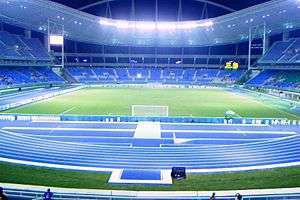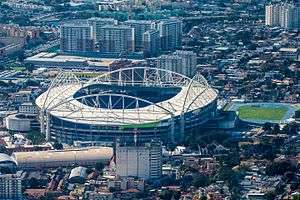Estádio Olímpico João Havelange
| Estádio Nilton Santos, Engenhão | |
|
Aerial view of the stadium, 2016 | |
| Location | Rio de Janeiro, Brazil |
|---|---|
| Public transit | Olímpica de Engenho de Dentro Station, SuperVia |
| Owner | Prefecture of Rio de Janeiro |
| Operator | Botafogo |
| Capacity | 46,931,[2] 60,000 (olympics) |
| Field size | 105 m × 68 m (344 ft × 223 ft) |
| Surface | Grass |
| Construction | |
| Built | 2003–07 |
| Opened | 2007, 2016 |
| Construction cost |
R$380 million[3] (US$192 million) |
| Architect | Carlos Porto[4] |
| Tenants | |
| Botafogo (Série A) (2007–present) | |
The Estádio Olímpico João Havelange (Portuguese pronunciation: [iʃˈtadʒw oˈɫĩpiku ˈʒwɐ̃w̃ ɐveˈlɐ̃ʒi]; English: João Havelange Olympic Stadium) also known as Nilton Santos Stadium (Brazilian footballer) is a multi-purpose stadium located in the neighbourhood of Engenho de Dentro in Rio de Janeiro, Brazil. It is used mostly for football matches and athletics and is the home stadium of the football club Botafogo. The stadium was built by a consortium under the leadership of Odebrecht S.A., from 2003 through to 2007, opening in time for the 2007 Pan American Games.[1][5] It hosted the athletics competitions at the 2016 Summer Olympics and the 2016 Summer Paralympics.[6]
The stadium is known by a number of names. The nickname Engenhão ([ẽʒẽˈɲɐ̃w̃]) refers to the location of the stadium. The stadium is named after former FIFA president and IOC member João Havelange. Havelange died during the 2016 Olympics at age 100. Since 2015 the Rio municipality has allowed Botafogo to refer to the stadium as Estádio Nilton Santos (English: Nilton Santos Stadium). The name honors Nilton Santos, regarded as one of the greatest defenders in the history of the game and a member of the World Team of the 20th Century. Botafogo attempted to have the official name of the stadium change but this was rejected.[7] Structural problems in the roof were identified in March 2013 that caused the stadium to be closed for repair. The stadium's capacity is intended to be increased to 60,000 for the Games.[8]
History
Construction and opening

The stadium cost R$380 million (US$192 million)[9] to build, which was six times the stadium's original construction budget of R$60,000,000[3] The Mayor's office estimated in 2003 that the total construction cost would be of R$60 million (US$30 million);[10][11] the actual cost was thus 533% higher than early estimates.[12]
The stadium opened on 30 June 2007. The first match held was a Campeonato Brasileiro Série A game between Botafogo and Fluminense. 40,000 tickets were available for the match and were exchanged for donations of powdered milk.[13] In all, 43,810 people were at the stadium to watch the inaugurating match, where Botafogo beat Fluminense 2–1. The first goal of the match was scored by Fluminense's Alex Dias. As Dias scored the first goal in the stadium's history, he was awarded the Valdir Pereira Trophy (Taça Valdir Pereira), which was named after retired footballer Didi. Because Botafogo won the stadium's inaugural match, the club was awarded the João Havelange Trophy (Taça João Havelange).[14]
Pan American Games, Botafogo and the Olympics

During the course of the 2007 Pan American Games held in Rio de Janeiro in July, the stadium hosted athletics competitions, in addition to twelve games of the first stage of the men's and women's football tournaments.[17] After the conclusion of the games, on 3 August 2007, Botafogo de Futebol e Regatas signed a deal with the City of Rio de Janeiro to rent the stadium for 20 years.[18] Botafogo was the only organization to present a bid; the club agreed to pay $18.200 (or R$36.000) a month to rent Engenhão, plus maintenance costs which run at $2 million (or R$4 million) annually.[3] On 11 August 2007, a 15-meter long and 6-meter high stadium wall collapsed, but nobody was hurt.[19] On 10 September 2008, the Brazilian national team played for the first time at the Engenhão.[20] The match, against Bolivia, for 2010 World Cup Qualification, ended 0–0.[21]
The stadium remains owned by the City of Rio de Janeiro, but it has been rented to Botafogo until at least 2027 (20 years).[18] The Engenhão was the main venue for top-football competitions in Rio de Janeiro while the Maracanã Stadium was being renovated in preparation for both the 2014 FIFA World Cup and 2016 Summer Olympics. Flamengo and Fluminense played their home matches at the Engenhão from the 2010–11 through 2012–13 seasons. The stadium was closed indefinitely in March 2013 after it was found the structural integrity of the roof was not up to standard, and could potentially place spectators at risk.[22] It was announced on 8 June 2013, that the stadium will need a minimum of 18 months of reconstruction work and remain closed until 2015 while the repairs are carried out to the roof.[23]
Other uses
Occasionally, the stadium also hosts concerts and has become a major location for this purpose in Rio de Janeiro since it opened, but more significantly after the Maracanã Stadium was closed in 2010 for renovations in preparation for World Cup 2014. Among the artists who have performed at the stadium include: Paul McCartney (Up and Coming Tour, 22 & 23 May 2011), Justin Bieber (My World Tour, 5 & 6 October 2011) and Roger Waters (The Wall Live, 29 March 2012). For live concerts, the stadium can hold from 20,000 to 45,000 people.
Gallery
-

Exterior shot of the stadium during the 2007 Pan American Games, looking from the east, July 2007
-

Exterior shot of the stadium looking form the north west, November 2007
-
Interior view of the stadium, looking towards the eastern grandstand, October 2008
-
.jpg)
Panoramic shot of the stadium during a Série A football match, October 2009
-
The statue of footballer Nilton Santos, situated outside the stadium, November 2009
References
- 1 2 "Prefeito permite, e Engenhão "vira" Estádio Nilton Santos". Terra Brasil (in Portuguese). 10 February 2015. Retrieved 12 February 2015.
... o nome oficial continua sendo Estádio Olímpico Municipal João Havelange ...
- ↑ "João Havelange Sports Complex". Brazilian Olympic Committee. Archived from the original on 9 June 2007. Retrieved 30 June 2007.
- 1 2 3 Bandeira, Luiza (3 August 2007). "Clube Botafogo administrará estádio olímpico do Engenhão". Agência Brasil (in Portuguese). Retrieved 1 July 2015.
- ↑ "Engenhão foi inspirado em Niemeyer". Lancenet (in Portuguese). Microsoft. 30 June 2007. Archived from the original on 27 September 2007. Retrieved 10 July 2007.
- ↑ "Prefeito permite que Engenhão mude para Estádio Nilton Santos". Fox Sports (in Portuguese). 10 February 2015. Retrieved 10 February 2015.
- ↑ "Brazil confident ahead of Rio 2016". BBC. Retrieved 16 August 2016.
- ↑ Resende, Leandro (25 March 2015). "Troca de nome do Engenhão é rejeitada na Câmara Municipal". O Dia (in Portuguese). Retrieved 29 June 2015.
- ↑ "Rio stadium roof problems serious, say engineers". euronews. 27 March 2013. Archived from the original on 2 April 2013. Retrieved 30 June 2015.
- ↑ As per the average exchange rate in 2007.
- ↑ Leister Filho, Adalberto; Grijó, Fabio; Rangel, Sérgio (1 July 2007). "Abertura do Engenhão ressuscita tradições" (PDF). Folha de S.Paulo (in Portuguese). Retrieved 1 July 2015 – via Centro de Memória Inezil Penna Marinho.
- ↑ Rangel, Sérgio (23 May 2007). "Vereadores do Rio aprovam CPI para investigar o Pan-2007". Folha de S.Paulo (in Portuguese). Retrieved 29 June 2015.
- ↑ estádio olimpico de atletismo detalhado e demarcado
- ↑ "Clássico entre Botafogo e Fluminense não terá venda de ingressos" (in Portuguese). Jornal do Brasil. 2007-06-22. Archived from the original on 2007-07-03. Retrieved 2007-06-23.
- ↑ "Na inauguração do Engenhão, Bota vence Flu e dispara na ponta". UOL Esporte (in Portuguese). 30 June 2007. Retrieved 30 June 2007.
- ↑ Rubinroit, Seth (3 May 2016). "Blue running track installed at Rio Olympic Stadium". NBC Olympics. NBCUniversal (Comcast). Retrieved 24 July 2016.
- ↑ Huebsch, Tim (15 May 2016). "Photos: New, royal blue track unveiled at Rio's Olympic stadium". Canadian Running. Gripped Publishing. Retrieved 24 July 2016.
- ↑ "Schedule and Results". 2007 Pan American Games official website. Archived from the original on 2007-08-18. Retrieved 2007-07-21.
- 1 2 "Botafogo vai administrar estádio olímpico do Engenhão" (in Portuguese). Correio Web. Retrieved 2007-08-28.
- ↑ "Muro do Engenhão desaba no Rio sem deixar feridos" (in Portuguese). A Tarde On Line. 2007-08-11. Retrieved 2007-08-28.
- ↑ "Seleção principal estréia no Engenhão com bom retrospecto do Pan" (in Portuguese). UOL. 2008-09-09. Retrieved 2008-09-11.
- ↑ "Sob vaias, Brasil é apático e apenas empata com a Bolívia". Gazeta Esporttva (in Portuguese). 2008-09-10. Retrieved 2008-09-11 – via Futebol de Norte.
- ↑ "Rio Olympics stadium closed due to roof problems". BBC News. British Broadcasting Corporation. 27 March 2013. Retrieved 2013-03-27.
- ↑ "Rio 2016 athletics venue to be closed until year before Games while urgent repairs carried out". Inside the Games. Dunsar Media. Retrieved 2013-07-15.
External links
| Wikimedia Commons has media related to Estádio Olímpico João Havelange. |
| Preceded by Olympic Stadium London |
Olympic Athletics competitions Main Venue 2016 |
Succeeded by TBD |
| Preceded by Olympic Stadium London |
Paralympic Athletics competitions Main Venue 2016 |
Succeeded by TBD |
Coordinates: 22°53′35.42″S 43°17′32.17″W / 22.8931722°S 43.2922694°W



